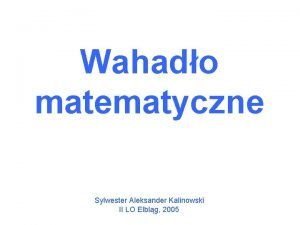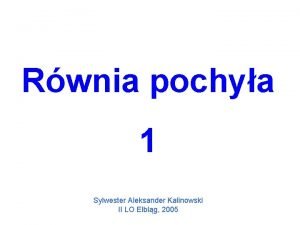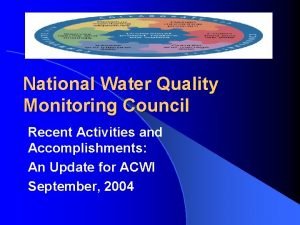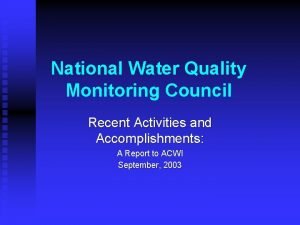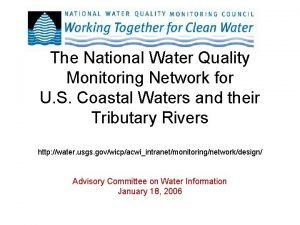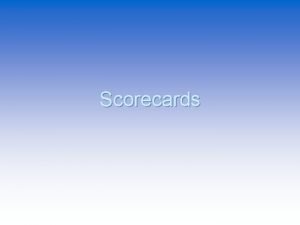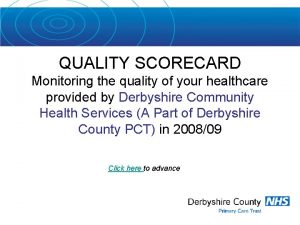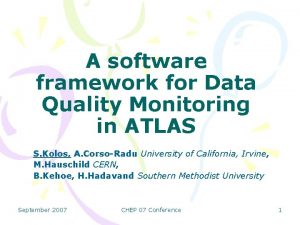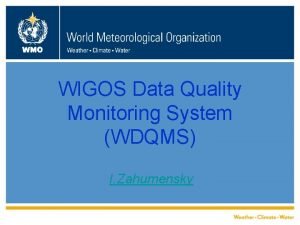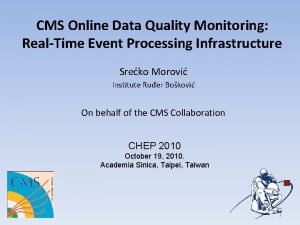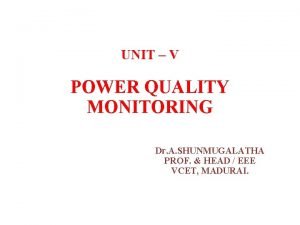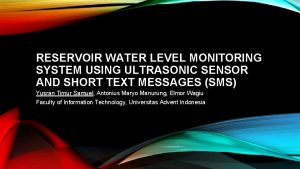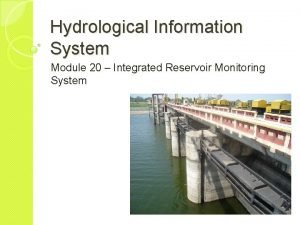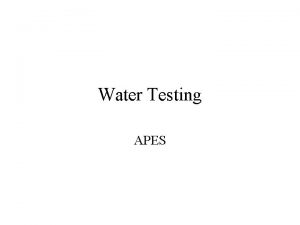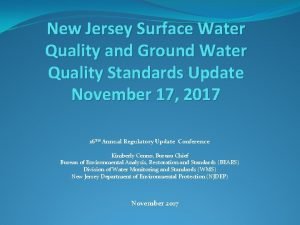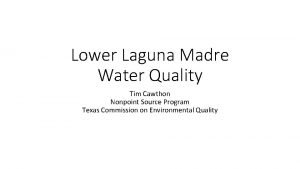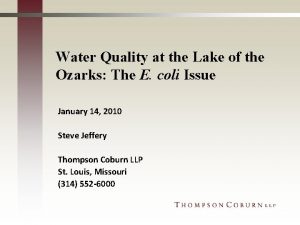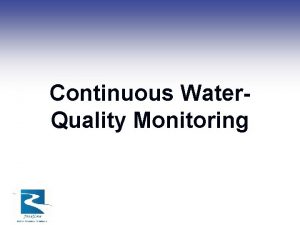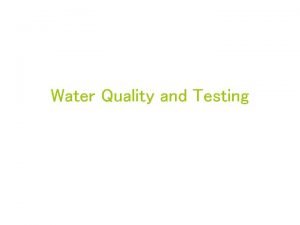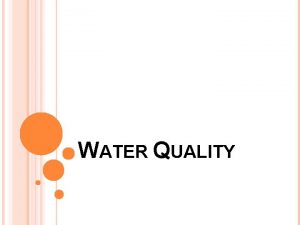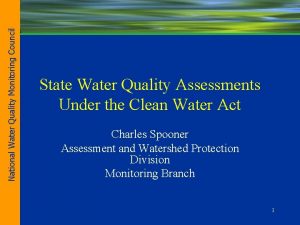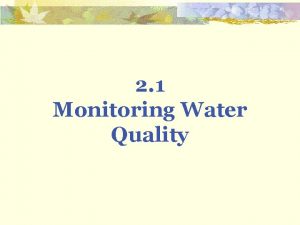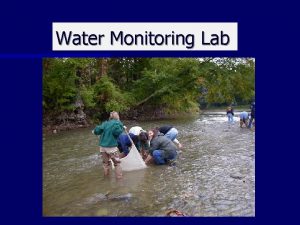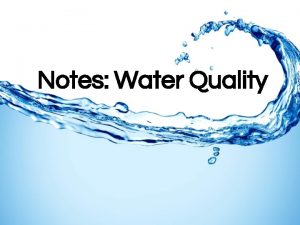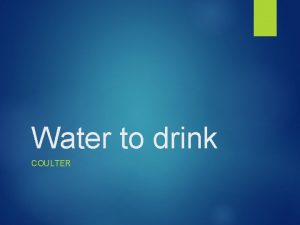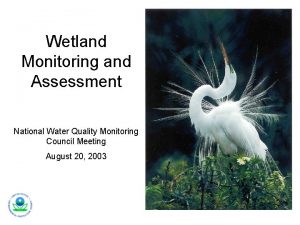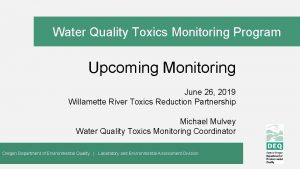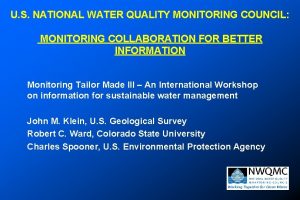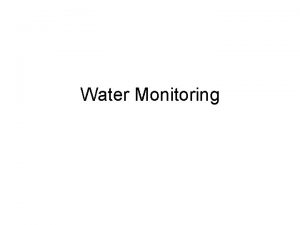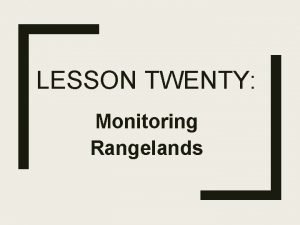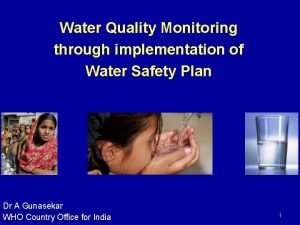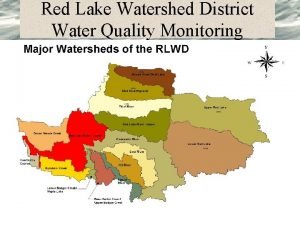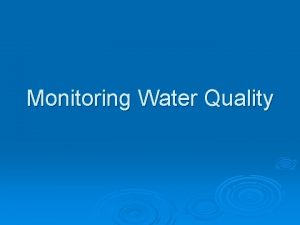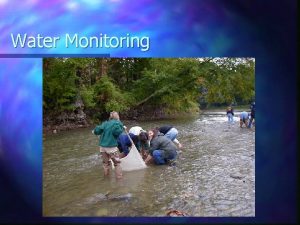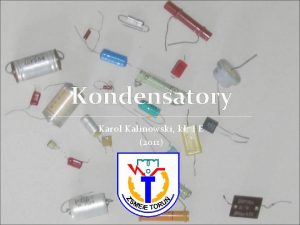Lesson 8 Water Quality Monitoring Prof Sawomir Kalinowski




























- Slides: 28

Lesson 8: Water Quality Monitoring Prof. Sławomir Kalinowski, Dr Zakhar Maletzkyi Norwegian University of Life Sciences Zakhar. Maletzkyi@nmbu. no

The Earth’s crust is composed largely of water Freshwater comprises only 3% of the total water available for us Water – the facts More than 80 countries now have water deficits Of that, only 0. 06% is easily accessible Satinder Ahuja, Monitoring water quality, pollution assessment, and remediation to assure sustainability Water Quality Monitoring 2

Potable water It is any water suitable for human consumption Water quality characteristics: • • physicochemical, organoleptic, microbiological, radioactive componds. Water Quality Monitoring Waterquality regulat vary in ions the diff erent p of the w arts orld Minimum frequency of analysis of water samples is dependent on the volume delivered or produced water in the supply zone 3

Sources of potable water Rivers Natural springs Water Quality Monitoring Lakes Wells 4

Organoleptic and physicochemical requirements* Parameter Aluminum Ammonium Chlorides Conductance Iron Manganese Oxidibizality with KMn. O 4 p. H Sulfates Sodium Turbidity * Polish legislation Water Quality Monitoring Maximum value ranges 200 µg/L 0. 50 mg/L 2. 500 µS/cm 200 µg/L 5 mg/L 6. 5 -9. 5 250 mg/L 200 mg/L 1 NTU 5

Additional chemical requirements* Parameter Bromodichloromethane Chlorine (free) Chloramines Chlorates and chlorites (total) Ozone Formaldehyde Dibutyl phthalate Magnesium Silver Tetrachloromethane Trichlorobenzenes (total) 2, 4, 6 trichlorophenol Trichloromethane Hardiness Water Quality Monitoring Permissible ranges** 0. 015 mg/L 0. 3 mg/L 0. 5 mg/L 0. 7 mg/L 0. 050 mg/L 5 mg/L 30 -125 mg/l 0. 010 mg/L 0. 002 mg/L 0. 020 mg/L 0. 200 mg/L 0. 030 mg/L 60 -500 mg/L * Polish legislation ** In the case of single value the minimum value of the range is equal to zero 6

Maximum permissible concentration of chemical contaminations* Contamination Maximum permissible concentration Lead 10 µg/L Acrylamide 0. 1 µg/L Mercury 1 µg/L Antimony 5 µg/L Nickel 20 µg/L Arsenic 10 µg/L Nitrates 50 mg/L Benzene 1. 0 µg/L Nitrites 0. 50 mg/L Benzopyrene 0. 01 µg/L Pesticides 0. 10 µg/L Boron 1. 0 mg/L Pesticides (total) 0. 50 µg/L Bromate 10 µg/L Polyaromatic 0. 10 µg/L Cadmium 5 µg/L hydrocarbons (total) Copper 2. 0 mg/L Selenium 10 µg/L Chromium 50 µg/L THM (total) 100 µg/L Cyanides 50 µg/L Trichloroethene and 10 µg/L 1, 2 dichloroethane 3 µg/L tetrachloroethene Epichlorohydrin 0. 10 µg/L (total) Fluorides 1. 5 mg/L Vinyl chloride 0. 50 µg/L THM – trichloromethane, bromodichloromethane, dibromochloromethane, thibtomomethane * Polish legislation Water Quality Monitoring 7

Microbiological requirements* Maximum permissible numer of microorganisms Escherichia coli – 0 cells per 100 m. L Enterococcus – 0 cells per 100 m. L * Polish legislation Water Quality Monitoring 8

Radioactive contaminations* Parameter Maximum permissible value Radon 100 Bq/L Tritium 100 Bq/L Approximate radiation dose 0. 1 m. Sv/year Natural radionuclide U 238 U 234 Ra 226 Ra 228 Pb 210 Po 210 Parametric concentration** 3. 0 Bq/L 2. 8 Bq/L 0. 5 Bq/L 0. 2 bq/L 0. 1 Bq/L Artificial radionuclide C 14 Sr 90 Pu 239/Pu 240 Am 241 Co 60 Cs 134 Cs 137 I 131 Parametric concentration** 240 Bq/L 4. 9 Bq/L 0. 6 Bq/L 0. 7 Bq/L 40 bq/L 7. 2 Bq/L 11 Bq/L 6. 2 Bq/L * Polish legislation ** Values calculated for a dose of 0. 1 m. Sv and the annual water consumption 730 L Water Quality Monitoring 9

Nonpoint sources of pollutions Overwhelming majority of water-quality problems are now caused by diffuse nonpoint sources of pollution: • agricultural land • urban development • forest harvesting Nonpoint source • the atmosphere Water Quality Monitoring contaminations are more difficult to effectively monitor, evaluate, than those from point sources, such as discharges of sewage and industrial waste 10

Contamination arised from the materials we use frequently to improve the quality of life • Combustion of coal and oil • Detergents • Disinfectants • Drugs (pharmaceuticals) • Fertilizers • Gasoline (combustion products) and additives • Herbicides • Insecticides Water Quality Monitoring 11

Some of contaminants are not monitored on a regular cycle • • MTBE (methyl tertiary buthyl ether) Herbicides Fertilizers Bisphenol A – endocrine disruptor, Pharmaceuticals extracted from plastic containers, dangerous for infants Perchlorate Mercury Arsenic Another dangerous contaminators, what shoud be monitored: ü Hexavalent chromium ü Six perfluorocarbons ü Seven sex hormones Water Quality Monitoring 12

Arsenic contamination Countries where the arsenic contamination of ground water was reported: o o o o Argentina Australia Bangladesh (the most suffered from this contamination) Cambodia Chile Prolonged drinking of arsenic China Ghana contaminated water can lead to Hungary arsenicosis in a large numer of India people, eventually resulting in a Mexico Nepal slow and painful death. Thailand Taivan It is estimated that arsenic contamination of United Kingdom groundwater can seriously affect the health Nited States Water Quality Monitoring of more than 200 milion people worldwide. 13

Water quality monitoring strategy Ø Tiered approach to monitoring water is prefered. Ø System would check for general changes in water quality and screen for possible contaminations. Ø More specific testing would identify the type and extent of contamination. Ø The quatity of testing methods may depend on financial restrictions as well as regulatory requirements. Ø Prioritization should be given to tests are easy to perform, especially on site and can detect substances causing a high risk to public health or give a wide description of the quality of water. Water Quality Monitoring 14

Water quality monitoring methods Real time monitoring Near real time within 1 4 h Traditional monitoring of water quality: sampling, transport, and analysis in laboratory Water Quality Monitoring 15

Traditional monitoring of water quality Ø Laboratory methods are lenghty and expensive Ø Sample may be compromised during transportation Ø Results do not necessarily reflect the current characteristics of water Water Quality Monitoring 16

Real time water quality monitoring Real time monitoring applications are based mainly on one or more following water quality parameters: Øturbidity Detection methods are more Øconductivity limited than laboratory Øtemperature methods, but their variety and capabilities are Ødissolved oxygen (DO) continuosly improving. Øp. H Øchlorophyll a Øultraviolet absorbance at 254 nm Most of advanced laboratory methods are not implemmented for field applications. Water Quality Monitoring 17

Sensor technology and computer network determine water characteristics in a dynamic way. Online real time monitoring and screening methods can be used to provide up to date information on water systems and warn against contamination. Water Quality Monitoring This enables faster response times and quicker adjustments to treatment methods, reducing the risk to public helath. 18

Multiparameter water quality sensor Water Quality Monitoring 19

Turbidity Potable water should have turbidity lower than 1 NTU Turbidity sensor: • Range 0 400 NTU • Resolution 0. 1 NTU Water Quality Monitoring 20

Conductivity Portable conductivity meter Specific resistance of ultra pure water: 18. 2 MΩ·cm Conductivity sensor Water Quality Monitoring 21

Dissolved Oxygen (DO) important gauge of water quality Changes in dissolved oxygen levels indicate the presence of microorganisms from sewage, urban or agriculture runoff or discharge from factories. A right level of oxidation reduction potential (ORP) minimizes the presence of microorganisms such as E. coli, Salmonella, Listeria. Levels of Turbidity below 1 NTU indicates the right purity of drinking water. Water Quality Monitoring 22

Dissolved Oxygen (DO) in fresh water Concentration of O 2 in water with 100% air saturation, temp. 20˚C, determined by the Henry’s law: [O 2] = 0. 282 mmol/kg [O 2 ]= 9. 03 mg/kg Dissolved oxygen concentrations can fluctuate daily and seasonally. Source: http: //www. fondriest. com/environmental-measurements/parameters/water-quality/dissolved-oxygen/ Water Quality Monitoring 23

Dissolved Oxygen (DO) Analytical measurement metods O 2 + 2 H 2 O + 4 e → 4 OH Source: http: //www. fondriest. com/environmental-measurements/equipment/measuring-water-quality/dissolved-oxygen-sensors-and-methods/ Water Quality Monitoring 24

Dissolved Oxygen (DO) Colorimetric methods The rhodazine D method is used to determine very low dissolved oxygen concentrations. Able to measure in the parts per billion (ppb). The indigo carmine method can be used for measuring dissolved oxygen concentrations between 0. 2 and 15 ppm (mg/L). Measuring dissolved oxygen by a colorimetric methods can be done with a spectrophotometer, colorimeter or a simple comparator. Source: http: //www. fondriest. com/environmental-measurements/equipment/measuring-water-quality/dissolved-oxygen-sensors-and-methods/ Water Quality Monitoring 25

Dissolved Oxygen (DO) Titration (Winkler method) Samples are collected, fixed and titrated, either in the field or in a lab. The sample should be fixed with the reagents as soon as possible to prevent oxygen levels from shifting due to agitation or atmospheric contact. Source: http: //www. fondriest. com/environmental-measurements/equipment/measuring-water-quality/dissolved-oxygen-sensors-and-methods/ Water Quality Monitoring 26

Utilizing living organisms for monitoring water quality Fish Clams Algae Mussels Daphnia Bioluminesence based assays Water Quality Monitoring 27

Drinking water contamination warning system Turn key systems (including valves, meters, sensors, pumps, automated remote software, etc. ) and processes monitor water quality levels online and real time to ensure that drinking water remains inside accepted safe levels. These water quality testing systems may be strategically place throughout municipal water systems at key points and may be programmed to alarm and communicate directly to the municipality officials by cell phone when contaminants are detected. This is an effective tool to thwart terrorism. http: //www. watercontaminationmonitoring. com/content/drinking-water-contamination-warning-systems Water Quality Monitoring 28
 Wahado
Wahado Mgcosa
Mgcosa Water and water and water water
Water and water and water water National water quality monitoring conference
National water quality monitoring conference National water quality monitoring council
National water quality monitoring council Nwqmc conference
Nwqmc conference National water quality monitoring conference
National water quality monitoring conference Quality monitoring scorecard
Quality monitoring scorecard Quality monitoring scorecard
Quality monitoring scorecard Dqmf
Dqmf Wigos data quality monitoring system
Wigos data quality monitoring system Real time data quality monitoring
Real time data quality monitoring Permanent power quality monitoring equipment
Permanent power quality monitoring equipment Reservoir water level monitoring system
Reservoir water level monitoring system Reservoir water monitoring systems
Reservoir water monitoring systems Perform quality assurance
Perform quality assurance Project quality management pmp
Project quality management pmp Pmbok quality management
Pmbok quality management Process of nursing audit
Process of nursing audit Compliance vs quality
Compliance vs quality Basic concepts of quality
Basic concepts of quality Gurus of total quality management
Gurus of total quality management Quality is free: the art of making quality certain
Quality is free: the art of making quality certain What is tqm
What is tqm Turbidity apes
Turbidity apes Water quality act of 1965
Water quality act of 1965 Njdep groundwater quality standards
Njdep groundwater quality standards Tceq segment viewer
Tceq segment viewer Lake of the ozarks e coli
Lake of the ozarks e coli
